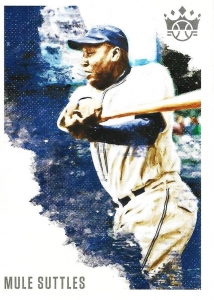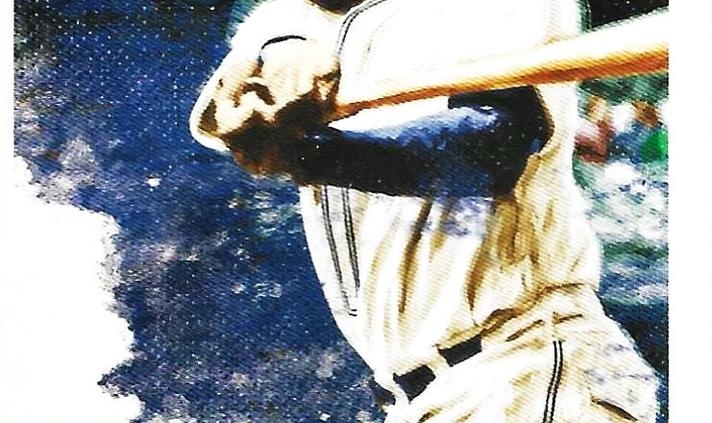August 11, 1935: The Mule Kicks the Maestro in Negro Leagues all-star game

At a time when a pint of Kentucky bourbon cost $1.251 and a round-trip train ticket between Chicago and Niagara Falls, the honeymoon capital of the world, cost $8,2 the stars of the Negro Leagues played one of the most dramatic ballgames ever. On a sunny Sunday afternoon in Chicago, 30,000 fans gathered to watch the best black baseball players compete in the third annual East-West Negro League All-Star game. Thirteen future Hall of Famers participated.3 They bore memorable nicknames like Cool Papa, Devil, Mammy, Submarine, Slim, and Turkey; but it was the battle between the Maestro and the Mule that determined the outcome. The fans were treated to an epic contest that featured two comebacks from four-run deficits and culminated in an 11th-inning walk-off home run by the game’s strongest power hitter off the best pitcher not named Satchel Paige.4
An All-Star game featuring black players was the brainchild of A.W. “Gus” Greenlee as a response to the severe anti-black repression that barred black athletes from the major leagues. Dire economic conditions of the 1930s precluded the Negro League World Series between 1928 and 1941,5 thereby making the All-Star Game the premier event for black players to showcase their skills. As noted in an announcement promoting the game, it was a battle between “teams which could enter either the American or National League and show their heels to the leaders.”6
The game, hosted by R.A. Cole, owner of Chicago American Giants, was played in the spacious Baseball Palace of the World, Comiskey Park. When it was built in 1910, the ballpark was the first symmetrical field in the major leagues — 362 feet down the foul lines and 420 feet in center. Designed to blend with the surrounding area, the exterior of Comiskey Park incorporated red brick archways similar to nearby factories. Built of steel and concrete, it was a departure from previous wooden structures. Innovations like turnstiles and ramps, instead of open gates and stairs, helped facilitate the safe flow of fans entering and exiting the facility. On the field, foul lines were old fire hoses pressed flat and painted white. The pitcher’s mound was like a jewel in the center of a diamond-shaped cutout in the infield grass.
In contrast to the major leagues, where sportswriters chose the All-Stars, fans elected the Negro League players using ballots distributed by weekly and daily newspapers and at Negro League games. The East team was chosen from the Brooklyn Eagles, Newark Dodgers, Philadelphia Stars, and New York Cubans. The West team was selected from the Chicago American Giants, Columbus Elite Giants, Pittsburgh Crawfords, and Homestead Grays. The fans cast over 150,000 ballots.7
Webster “Submarine” McDonald managed the East team that included Paul Arnold, Leon Day, Ray Dandridge, Martin Dihigo, Robert Evans, George Giles, Fats Jenkins, Slim Jones, Richard Lundy, Biz Mackey, Alejandro Oms, Dick Seay, Jake Stephens, Ed Stone, Luis Tiant Sr., and Jud Wilson.
Oscar Charleston managed the West team. His players were Cool Papa Bell, Larry Brown, Raymond Brown, William “Sug” Cornelius, James Crutchfield, Josh Gibson, Bob Griffith, Sammy T. Hughes, Buck Leonard, Leroy Matlock, Alex Radcliffe, Ted Trent, Felton “Mammy” Snow, Turkey Stearnes, Mule Suttles, Willie “Devil” Wells, Chester Williams, and Burnis Wright.
Known as The Maestro, Cuban-born Martin Dihigo was a tall, powerful switch-hitter who played every position, including pitcher. “He was the best ballplayer of all time, black or white,” a competitor said.8 In his best season he posted a 0.90 ERA and went 18-2 while hitting a league-leading .387. In addition to being enshrined in the National Baseball Hall of Fame in Cooperstown, Dihigo is the only player also inducted in the baseball halls of fame in Cuba, Mexico, the Dominican Republic, and Venezuela.
George “Mule” Suttles was a gentle giant. He did not seek the limelight like his more famous contemporaries; he let his 50-ounce bat do the talking. Over a 25-year period, Suttles averaged 34 homers and compiled a .327 career batting average. Where Josh Gibson hit vicious line drives, Mule was known for gargantuan blasts. In a game played in Havana, Mule crushed a ball over the center-field fence that witnesses swore cleared the 60-foot-high wall and traveled over the heads of the mounted policemen patrolling outside the ballpark — a distance of 600 feet.9 In a game against the Memphis Red Sox, he hit three homers in the same inning. On this day in 1935, he saved his best for last.
Over the first six innings, the East built a 4-0 lead on the strength of timely hitting, including an RBI single by Dihigo to plate the first run. East pitcher Slim Jones mesmerized the West during his three-inning stint. He helped his cause by blasting a homer into deep right field. His successors on the hill did not fare as well. Leon Day was roughed up for three runs in the home sixth and another in the seventh to tie the score. Lefty Luis Tiant followed Day and held the West until he faltered in the 10th.
Meanwhile, the West’s pitching held until Bob Griffith entered the tie game to pitch a disastrous 10th in which he yielded four runs. His outing would have been much worse without a great shoetop catch by Mule Suttles. With the East’s seemingly commanding lead, fans began to head for the exits.
Their exodus did not last long. In the bottom of the 10th, Luis Tiant Sr. ran into trouble. With one run in and the bases loaded with none out, manager McDonald turned to Dihigo, who stopped the carnage. Fans who returned to their seats were treated to a storybook ending.
In the home 11th, Martin Dihigo made a grievous mistake; he walked Cool Papa Bell, the legendary speedster. The inimitable Satchel Paige once remarked that Bell was so fast that when he switched off the light, he was in bed before the room got dark.10 No doubt both teams recalled how in the All-Star Game a year earlier, Bell had plated the game’s only run by scoring from second base on an infield hit.11 In this game, East catcher Biz Mackey had gunned down three baserunners attempting to steal and picked Ray Dandridge off third to end the West’s threat in the 10th, and manager Charleston signaled for a sacrifice. Hughes executed a bunt perfectly, advancing Bell to scoring position. One down.
As the number-three hitter, Chester Williams approached the plate, Dihigo glanced at the on-deck circle. The imposing figure of Josh Gibson settled onto one knee to watch the confrontation. Gibson had already collected four hits, including a ringing double in the sixth inning that Dihigo tried to catch before crashing into the center-field wall. Whether later in the game Dihigo suffered from the effects of the collision is a matter for conjecture.
The pitcher made quick work of Williams, striking him out. Two down.
In the West’s dugout, Mule counseled the relief pitcher Sug Cornelius.
“Go up there and kneel in the on-deck circle, Cornelius, they’ll think you’re up next.”12
With so many substitutions in an All-Star Game, Suttles counted on confusion in the opposing dugout regarding the proper batting order at this point. As Cornelius hefted a couple of bats in the on-deck circle, Mackey signaled for an intentional walk to Gibson. The walk to Gibson was imperative. Why give one of the greatest batters of all time a chance to win the game when a walk would set up a force play at any base?
As Gibson ambled to first, Suttles emerged from the dugout. The PA announcement crackled over the speakers:
“Now batting for the West squad, THE MULE!”13
Dihigo shot a contemptuous look at the West’s dugout for the gamesmanship. With two out and two on, Dihigo was confident he could get Mule out. The hometown fans rose to their feet, exhorting the local star with his trademark cheer: “Kick, Mule! Kick, Mule!”
Suttles who had already walked four times, relished the opportunity to hit. In the on-deck circle, Mule swung five bats before entering the batter’s box.
The Maestro was the epitome of determined concentration as he glared toward the plate. After checking the runners, he unleashed a ball that sizzled as it bore in on Mule. Thwapp!
“Inside. Ball one,” shouted the umpire, barely audible over the noisy crowd.
The next pitch was a perfect strike at the letters. Mule nodded, exhaled, and stepped back. He bent, grabbing some dirt to dry his hands. He practiced a half-swing with his fearsome black bat. Settling back in the box, Mule locked his eyes onto the area next to Dihigo’s right ear where the ball would soon appear.
What happened next is best described in a poem entitled “Lament on the East-West Game” that appeared in the Philadelphia Tribune:
The bat met ball, the ball passed the fence
And with it went the East team’s chance
Turn back, oh time, but the deed is done
Mule Suttles’ homer the game has won.
And so, my friends, Mac knows full well
That managing, like war, is hell.14
Notes
1 Chicago Tribune, August 10, 1935: 15.
2 Chicago Tribune, August 5, 1935: 16.
3 Members of the National Baseball Hall of Fame in Cooperstown, New York: Cool Papa Bell, Raymond Brown, Oscar Charleston, Ray Dandridge, Leon Day, Martin “The Maestro” Dihigo, Josh Gibson, Buck Leonard, James “Biz” Mackey, Turkey Stearnes, Mule Suttles, Willie “Devil” Wells and Jud Wilson.
4 Instead of attending the East-West All-Star game, Satchel Paige accepted a better monetary offer to play for an integrated team called the Bismarck Churchills and led them to victory in the semipro National Baseball Congress Championship at Wichita, Kansas. nbcbaseball.com/about-us/history/ (retrieved February 4, 2018).
5 Larry Lester, Black Baseball’s National Showcase (Lincoln: University of Nebraska Press, 2001), 1. (hereinafter cited as Lester Compilation).
6 “Expect 30,000 at All-Star Game Sunday,” Chicago Defender, August 10, 1935, reproduced in Lester Compilation, 69.
7 “Colored All-Star Nines Meet in East-West Game Today” Chicago Tribune, August 11, 1935: 2, 4.
8 National Baseball Hall of Fame website page for Martin Dihigo. Quote attributed to Buck Leonard baseballhall.org/hof/dihigo-mart%C3%ADn (retrieved February 4, 2018).
9 John B. Holway, Blackball Stars (Westport, Connecticut: Meckler Books, 1988), 267. (hereinafter cited as Holway).
10 William Gildea, “On Today’s Scene: Paige Admits He’s Feeling His Age” Washington Post, April 29, 1969: D2.
11 William G. Nunn, “ ‘Satch’ Stops ‘Big Bad Men’ of West Team,” Pittsburgh Courier, September 1, 1934, reproduced in Lester Compilation, 57.
12 Holway, 276-77.
13 Holway, 270.
14 Ed Harris, Lament on the East-West Game, Philadelphia Tribune, August 29, 1935, reproduced in Lester Compilation, 77.
Additional Stats
Corrections? Additions?
If you can help us improve this game story, contact us.


